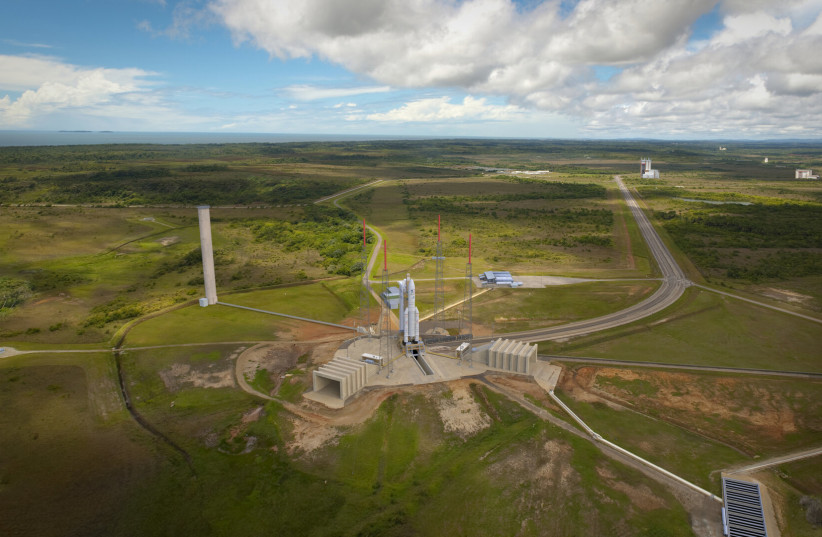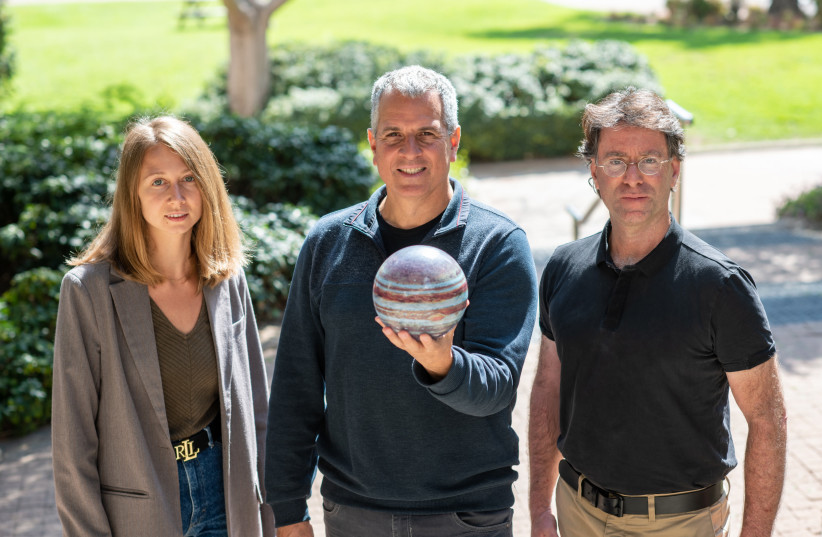The European Space Agency’s (ESA) JUICE mission‘s anticipated launch on Thursday was postponed until Friday due to poor weather at the European spaceport in French Guiana.
Today’s launch is postponed because of lightning risk. See you tomorrow! https://t.co/S6tUKukJDX
— ESA (@esa) April 13, 2023
Today’s launch is postponed because of lightning risk. See you tomorrow! https://t.co/S6tUKukJDX
The mission, when it does launch, is set to bring several experiments, including from Israel’s Weizmann Institute of Science, on a bold new journey to Jupiter and its moons. The launch is set to begin at 3:15 p.m. Israel time.
The JUICE (Jupiter Icy Moons Explorer) mission is the ESA’s biggest mission ever, and the Israeli participation is funded by the Israel Space Agency, which is under the auspices of the Science and Technology Ministry. It will be the first time Israeli technology will go beyond Earth’s orbit.
The unmanned probe will be launched on an Ariane 5 rocket as it breaches the atmosphere on its 900 million kilometer journey, first doing a flyby of Venus and then three flybys of Earth. This will help the probe build up enough momentum to be slingshotted toward Jupiter.
It is estimated that the probe won’t arrive at Jupiter until July 2031, when it will officially start its four-year mission: Circling the largest planet in the solar system nearly 100 times while studying its atmosphere as well as exploring the moons of Ganymede, Callisto and Europa.
What is Israel’s role in the JUICE mission to Jupiter?
Tagging along for the JUICE mission is a major experiment led by Prof. Yohai Kaspi and Dr. Eli Galanti from Weizmann, which will let them probe Jupiter’s atmosphere.
 The JUICE probe, which stands for Jupiter Icy Moon Explorer, is getting ready for launch. (credit: ESA)
The JUICE probe, which stands for Jupiter Icy Moon Explorer, is getting ready for launch. (credit: ESA)This isn’t the first time the two of them have been involved in international space missions. Kaspi in particular has made waves in the past with his research on Jupiter. Back in 2021, working off data from NASA’s Juno mission, he was able to produce the first-ever in-depth measurement of Jupiter’s famous red spot, revealing new information on the formation of storms on the planet.
Now, he and Galanti are set to make a similar breakthrough.
“What we’re doing is sending a radio beam from the spacecraft to Earth and when it goes through the atmosphere, it gets distorted which lets us get temperature readings,” Kaspi told The Jerusalem Post.
“We will build a 3D map of Jupiter’s temperature, which no one has ever done before,” he said, noting that the JUICE mission will be complimentary to the data gleaned from Juno.
“We will build a 3D map of Jupiter’s temperature, which no one has ever done before.”
Prof. Yohai Kaspi
“We will build a 3D map of Jupiter’s temperature, which no one has ever done before.”
This is helped by the unique orbit of the JUICE probe.
“JUICE’s main goal is to study the icy moons so the orbit is going to be very unique, meaning we can get these samples over different locations on Jupiter,” Kaspi said. “We’re taking advantage of that to be able to study the atmosphere itself and beneath it.”
It can also help solve the mystery of whether Jupiter has a solid core. It has long been a belief by scientists that gas giants like Jupiter have solid cores, but some scientists have begun finding this less likely.
“We think it might have a diffused core or fuzzy core, something more like mixed plasma rather than rock,” Kaspi said.
 Weizmann Institute participants in the JUICE mission to Jupiter (l-r): Maria Smirnova, Prof. Yohai Kaspi and Dr. Eli Galanti (credit: WEIZMANN INSTITUTE OF SCIENCE)
Weizmann Institute participants in the JUICE mission to Jupiter (l-r): Maria Smirnova, Prof. Yohai Kaspi and Dr. Eli Galanti (credit: WEIZMANN INSTITUTE OF SCIENCE)He also noted that it could help shed light on the origins of the solar system itself, since Jupiter is the oldest planet.
The Jerusalem-made Israeli clock going to Jupiter
All of these discoveries will be made possible through the use of an Ultra Stable Oscillator, an extremely complex and sensitive clock that will let it conduct some of the most precise measures humanly possible.
“It’s so accurate that if you ran it for 100,000 years, it would only lose less than a second,” the Weizmann scientist said.
The way this instrument was built in the first place was almost by accident.
“The oscillator should have come from NASA,” Kaspi explained, noting that the JUICE mission was originally a joint effort between the ESA and NASA. “But then NASA had budget cuts and decided to pull out. So we started looking for another way to make one, and pretty much by chance, we bumped into the Israeli company AccuBeat.”
Based in Jerusalem’s Har Hotzvim Industrial Zone, AccuBeat is one of the few companies in the world that make atomic clocks. However, at that point, it wasn’t involved in space technology and was limited to making clocks for civilian and military use.
“AccuBeat’s vast experience and knowledge helped the development of technology with unprecedented capabilities,” said AccuBeatCEO Benny Levy. “We are proud and excited to be part of a historic research project, the results of which can very well lead to sensational discoveries in the world of science, space and humanity as a whole.”
While this is the first time Israel-made technology is going out of Earth’s orbit, it’s also a landmark moment for the ESA.
“Until now, the outer solar system was only NASA’s territory, but now ESA is going to Jupiter on an independent mission,” Kaspi said.
Studying the mysteries of Jupiter’s icy moons and unforeseen NASA joint experiments
In addition to studying Jupiter’s atmosphere, the Weizmann scientists will also be helping study the moons.
“The moons have an ionosphere, think of it as a very thin layer of atmosphere. It’s so thin that it’s more like ions floating around in space. We’ll be studying those,” Kaspi explained.
“The icy moons might also have some plumes of water spitting out into space from subterranean oceans, and JUICE is trying to measure those too. The main mission is to characterize the oceans of water.”
Jupiter’s moons have long been the subject of fierce scientific curiosity. These three moons in particular are completely frozen over, cover in ice. But beneath that ice is believed to be vast oceans of still liquid water – something supported by prior magnetic field measurements. In fact, these planets could possibly possess the solar system’s single largest quantity of water.
And since liquid oceans also imply the presence of heat to keep the water in its liquid form, it can also offer the tantalizing possibility of finding alien life – or at the very least, if the moons can support life.
In fact, NASA has also planned a mission to the moon Europa for the same reason, the Europa Clipper, organized after it had pulled out of JUICE, which is set to be launched in October 2024 – though because of the different rocket used, it may actually arrive at Jupiter before JUICE does.
This is a further groundbreaking prospect as it means there will be two probes around Jupiter at the same time – something that has never happened before.
“These outer-solar system probes usually only happen around once per decade,” Kaspi said. “mission. This has actually turned out interesting because if you have two points of view around Jupiter, you can do some unique experiments.
“One of the things we’re going to be doing until then are joint science missions. None of this was originally planned but now we can initiate new experiments.”